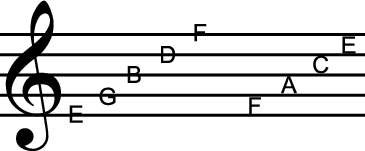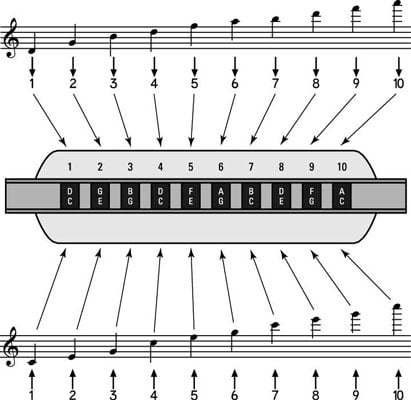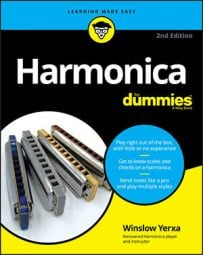Music notation tells you which notes to play and when to play them. However, notation doesn’t tell you how to get the notes on the harmonica or on any other instrument; those specifics are left up to you. Here are some basics of reading written notes and relating them to a C-harmonica.
Placing notes on a staff
Notes are written on a stack of five horizontal lines called the staff. The notes are represented by oval shapes that are placed either on the lines or in the spaces between the lines; low notes are placed low on the staff and high notes are placed high on the staff.
A staff can represent any range of notes, so a clef is placed at the beginning of the staff to indicate the location of one specific note, such as G, C, or F. From that note you can count up and down to figure out which notes lie above and below.
For instance, the treble clef is a stylized letter G, and it wraps around the line where G above middle C is written. From that G you can count up and down to figure out where the rest of the notes are.
A staff with a treble clef is often called the treble staff.

Here are some simple ways to remember which notes in the treble staff are on which lines and spaces:
The lines are used to write these notes: E G B D F. And here’s the common mnemonic device folks use to remember the ascending order of the notes that go on the lines: Every Good Boy Deserves Fudge.
The spaces are used to write the notes F A C E, which together spell “face.”
Some high notes go above the staff, while some low notes go below the staff. You write these notes by adding more lines above or below the staff and then writing the notes on or between the added lines. These added lines are called ledger lines. You use them whenever you have notes that extend above or below the staff.

To make things easier to read, you can write the notes above the staff one octave lower. To show that these notes should be played an octave higher than written, you place 8va above them, along with a dotted line.

Writing sharps and flats on the staff
On the staff, sharps, flats, and naturals are symbols placed in front of a note to raise or lower its pitch by a semitone. Here are some guidelines to follow when reading these symbols:
Assume that a note is a natural note unless you find out otherwise.
A flat is used to lower the pitch of a natural note by one semitone.
A sharp is used to raise the pitch of a natural note by one semitone.
If a note has been flatted or sharped and is now going back to being a natural note, the natural symbol is used.

When sharps, flats, or naturals are written in front of a note, they’re called accidentals. An accidental applies only during the measure in which it occurs.
Unlocking key signatures
A key signature is the group of sharps or flats needed to create a major scale in a particular key. On the staff, a key signature appears at the beginning of the line as one or more sharps or flats. It tells you which notes are automatically changed to sharps or flats to fit the key.

When you contradict the key signature to temporarily raise (sharpen) or lower (flatten) a note in the scale, you use an accidental. If a note is flatted or sharped in the key signature and you’re changing it back to a natural, you use the natural sign.
You see accidentals a lot in harmonica music because a lot of harmonica music — blues especially — uses a scale that’s a little different from the major scale. Plus, when you bend notes, the bent notes are often outside the scale.
Finding harmonica notes on the staff
Check out all the notes in a C-harmonica on the treble staff. The draw notes are shown on a staff above the harmonica, and the blow notes are shown on another staff below. The arrows point from each note to the hole in the harmonica where the note is found.
The harmonica is designed to play chords whenever you play three or more holes at a time. The most basic type of chord is called a triad. The chords on a harmonica are fun to play and form an important part of the harmonica’s sound.
However, when you play chords, you should be aware of which chords they are. This way you can be sure they don’t clash with the chords being played when you play music with others.

The draw notes contain the following triads:
Holes 2, 3, and 4 form a G major triad (G-B-D), written on staff lines.
Holes 3, 4, and 5 form a B diminished triad (B-D-F), written on lines.
Holes 4, 5, and 6 (and also 8, 9, and 10) form a D minor triad.
Holes 7, 8, and 9 form another B diminished triad (B-D-F), written on spaces in between ledger lines above the staff.
Holes 8, 9, and 10 form another D minor triad, (D-F-A), written on spaces between ledger lines above the staff.
The blow notes form the following series of C triads:
C, E, and G in Holes 1, 2, and 3 are written on lines, starting with middle C on a ledger line below the staff.
C, E, and G in Holes 4, 5, and 6 are written on spaces.
C, E, and G in Holes 7, 8, and 9 are written on ledger lines. Hole 10 is C, which is written on a space above a ledger line.

